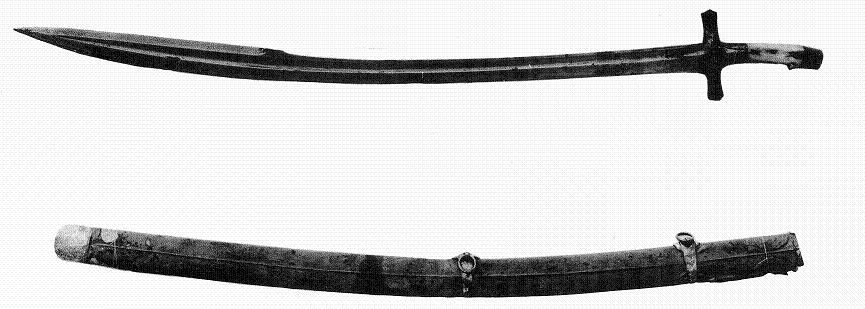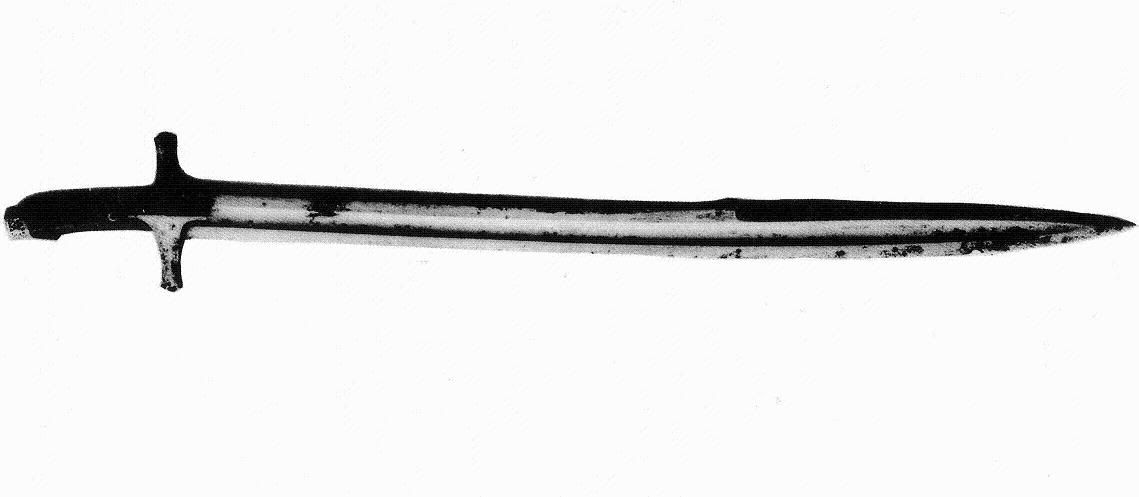
 |
|
|
|
|
#1 |
|
Member
Join Date: Dec 2004
Location: Ann Arbor, MI
Posts: 5,503
|
We are all familiar with Turkish Kilij: the broad curved blade with a pronounced Yelman.
Accepted wisdom is that the early Kilijes (~ 16-17th century) had an almost Yelman-less configuration, and that the classical form is a relatively late development. In the 18-19th centuries, the blades became shorter and the so-called Pala was born. Simple and straightforward, up to here. However, according to Unsal Yucel, there are no known examples of the truly Anatolian swords, be it Seljuk or Ottoman, prior to the reign of Mehmet II ( 1451-1481). Thus, although we have no idea what swords did the Turks carry early on, the Yelman form of Kilij came to them only in the 17th century. However, there are plenty of Mameluke swords with documented provenance. Apparently, Kilijes with massive Yelmans were popular in Egypt even in the 13th century. The pics are from Yucel's book. The first one is attributed to Muhammad ibn Qalawun, Mameluke sultan between 1299-1341. The second one is dated 1484, made by Abd al-Rahman ibn Muhammad Ustadh al -Misri (" master from Egypt") and has Pala-like proportions. Thus, the sword we know now as Ottoman Kilij came to Turkey proper only about 300-500 years of its use by the Mameluks. Did the Mameluks, who were mostly Central Asians and Caucasians, bring their national weapon with them? Is Kilij an old Kipchak or Khazar sword? Chinese influence? |
|
|

|
|
|
#2 | |
|
Member
Join Date: Mar 2007
Location: California
Posts: 7
|
I disagree with this assessment of the history of the kilic. For starters, the kilic you scanned from Yucel's book isn't dated to the 13th or early 14th century. Those dates are the dates of the rule of Qalawun, the Mamluk Sultan, not of the sword. Of the sword, Yucel actually says the following:
Quote:
The only 13th century curved sword Yucel considers to be authentic is one on the next page attributed to Husam al-Din Lajin. He says it is the earliest authentic example of an Islamic curved, single-edged sword. However, I am skeptical of this claim, as all other known curved swords of similar type date from no earlier than the 15th century. However, we have loads of examples of straight, double-edged swords dating from earlier periods. So I take this last attribution with a grain of salt. I'd also like to say that conventional wisdom doesn't state that the kilic was developed in the 16th-17th centuries, as there are very many examples of both Ottoman and Mamluk kilics from the 15th century, including the first half of that century. Cheers, Alina |
|
|
|

|
|
|
#3 |
|
Member
Join Date: Dec 2004
Location: Ann Arbor, MI
Posts: 5,503
|
I am intrigued: where did you see Ottoman kilijes dated first half of the 15th century? Even Yucel says that there are no surviving examples of Ottoman swords before Mehmet's reign.
Mameluke Kilijes? But of course! That was my point. The first sword was clearly defined as "attributed to". The second one, however, is dated. Astvatsaturyan ("Turkish Weapons", pp. 85-89) discusses Kilij belonging to Prince Mstislavsky ( died in 1540) and signed by Abdul Ali Kassem the Egyptian. Please provide proof of your assertion that there were Ottoman (NOT Mameluke!) Kilijes with Yelman before that time. Your quote of Yucel's description of an even earlier Mameluke Kilij seems to support my point, isn't it? |
|
|

|
|
|
#4 |
|
Member
Join Date: Nov 2004
Location: USA
Posts: 1,725
|
Hi Alina, good to see you here. Welcome.

|
|
|

|
|
|
#5 | |
|
Member
Join Date: Mar 2007
Location: California
Posts: 7
|
Quote:
As to the issue of the sword I mentioned supposedly dating from the 13th century, it would certainly support your case, were it 13th century, but I don't think it is at all. I think that sword is most probably 15th century. Besides which, it has practically no yelman at all, merely a sharpened false edge. To say that the pala of the 18th century stemmed from the 13th century Mamluks is completely wrong. Finally, your initial supposition was that the kilic with a yelman came to the Turks in the 17th century. That statement is fallacious. I don't think there's a kilic in Yucel's book from the 15th or 16th centuries that doesn't have a very pronounced Yelman. To back up my position, here are some kilics that date to the 15th and 16th centuries according to Yucel: My personal favorite, the kilic of Bayezid-i-sani and so is late 15th or early 16th century:  Kilic of Fatih Sultan Mehmet, and therefore 15th century:  Kilic with no attribution, considered to be late 15th century:  Kilic from the 15th century, no indication as to early or late:  Kilic from the 15th century, no indication as to early or late:  So, given that evidence, it would seem clear to me that the kilic with the yelman began springing up in the Mamluk Sultanate at the same time as the Ottoman Empire. With the exception of the lone curved sword Yucel dates to the 13th century, there is absolutely no evidence that the Mamluks developed the kilic, or that they were the first to come up with a yelman. Furthermore, such a theory wouldn't make much sense, as the Mamluks themselves came from many of the same Turkic regions where the Ottomans had lived before moving to Anatolia. Therefore, they would have access to the same weapons technology from that region. |
|
|
|

|
|
|
#6 |
|
Member
Join Date: Jun 2006
Location: Arabia
Posts: 278
|
Hello Alina!
 Very nice to see you here, how is it going with your kilij? Very nice to see you here, how is it going with your kilij?
|
|
|

|
|
|
#7 | |
|
Member
Join Date: Mar 2007
Location: California
Posts: 7
|
Quote:
 On the bright side, I chose to have Bayezid-i-sani's kilic copied and it's still my favorite even 18 months later. So, I guess I just have to keep waiting. On the bright side, I chose to have Bayezid-i-sani's kilic copied and it's still my favorite even 18 months later. So, I guess I just have to keep waiting.
|
|
|
|

|
 |
|
|